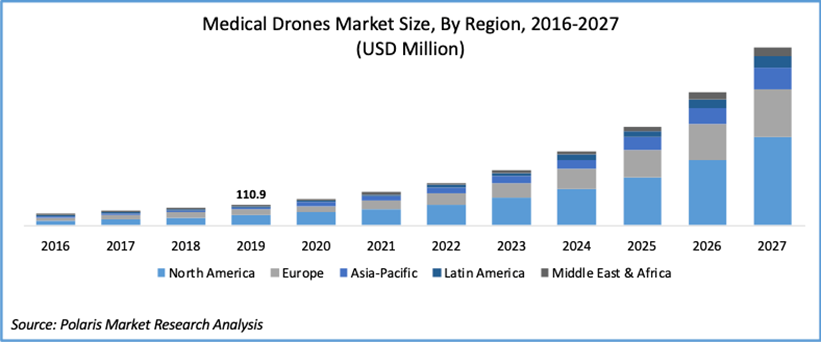
The global medical drones market was valued at USD 110.9 million in 2019 and is expected to grow at a CAGR of 31.6% to 2027, according to Polaris Market Research. “The prominent factors responsible for market growth are key government initiatives in providing medical care to the distant areas, rising fear of virus infection due to COVID, and as tool to cut down un-necessary logistics costs. Moreover, substantial investments in development of advanced medical drones, key technological advancements and growing public acceptance has also fueled the market growth. There are several major benefits that drive their deployment across a variety of end-uses such as in military, in floods or drought affected areas and pandemic affected areas where it is extremely harmful for humans to deliver medical supplies. Moreover, the rising applications of drones in the healthcare sector is also expected to prove a major driving factor to boost market growth.”
The report also concludes
“Rotor drone (sic) is expected to hold the highest share in global market in 2019, owing to various benefits such as its ability to land and take-off vertically which enables the user to operate it within a smaller region with no much area required to land or take-off as against the fixed wing medical drone that requires larger area to take-off and land. The capacity of rotor drone to hover and uniquely deliver agile maneuvering make the rotary wing unmanned Arial vehicle highly suited for applications such as remote inspection where ability to keep undisturbed visual on just one target of longer period of time is needed. However, the primary drawback of rotor drone is that its design and manufacturing requires greater electronic and mechanical complexity. This makes the repair and maintenance of rotor drones highly time-consuming, greater skills are required by the technician and also, increases the overall operational expenditures. Also, owing to shorter flight range of rotor drone and their lower speed it makes tedious for the operator to make several rounds of flight to survey a large area which takes a lot of more time and also increase the operations costs.”
“Based on end-use, the global market is segmented into Emergency Medical Services, Government Organizations, and Blood Banks. Among these, emergency services have occupied a majority of the market share in 2019, mainly due to sustained advancements in drone technology. These drones are generally being deployed for transferring platelets, plasma and blood from the blood banks to clinics and hospitals in remote locations….Geographically, North America is the largest revenue contributor to the medical drones market and holding a majority of the market share. The growth of North America medical drones market is mainly due to substantial research funding to the development of medical drones and extensive adoption of medical drones across various healthcare facilities such as hospitals, clinics and ambulatory surgical centers (ASCs). Moreover, the presence of key regulations that favor the deployment of drones in the healthcare sector across both United States and Canada also contributes to the market growth in the region.
“Furthermore, Europe is also expected to contribute notably to the growth of medical drones in the region mainly due to favorable government initiatives to boost the implementation of medical drones across the medical sector in countries such as Germany, France, United Kingdom, Italy, Belgium, etc. For instance, in 2018, DHL, which is a logistic major in Germany has launched small-sized drones that would be deployed for providing medications to costal and remote locations in the country. DHL has planned to innovate and introduce a new drone that would be capable of vertically taking-off and landing with no requirement of any land for take-off. Moreover, the advanced drone is expected to have temperature-controlled sensors that would enable drone to offer the medical supplies at much-needed temperature conditions.”
For more information
https://www.polarismarketresearch.com/industry-analysis/medical-drones-market

